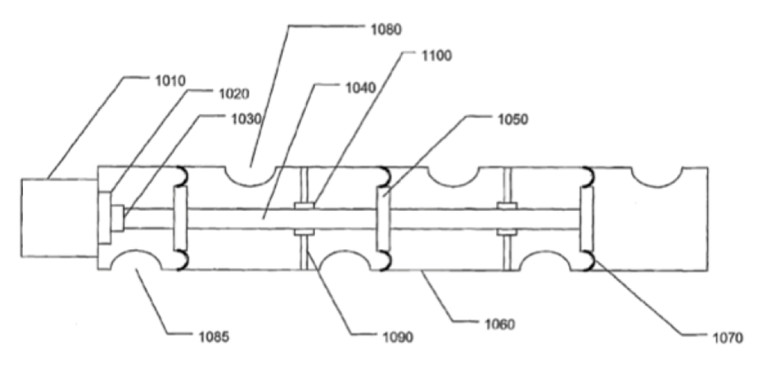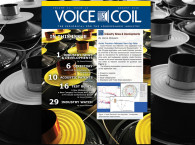
Acoustic Transducer Comprising a Plurality of Coaxially Arranged Diaphragms
Patent Number: 9,967,673
Inventor(s): David Andrew Unruh (San Jose, CA); Robert J. True (Pleasant Prairie, WI); Edward T. Norcott, Jr. (Los Gatos, CA); Jens-Peter Axelsson (Benicia, CA); Alireza Jabbari (Berkeley, CA); David J. Prince (Villa Park, IL); Kenneth L. Kantor (Berkeley, CA); Loannis Kanellakopoulos (Cupertino, CA); Shaolin Wei (San Diego, CA)
Assignee: Tymphany HK Ltd. (Wanchai, Hong Kong)
Filed: October 21, 2014
Current CPC Class: H04R 7/16 (20130101)
Granted: May 8, 2018
Number of Claims: 22
Number of Drawings: 24
Abstract from Patent
An acoustic transducer comprises one or more electromagnetic motors that drive one or more sets of multiple diaphragms to provide acoustically efficient loudspeaker systems having dimensions that allow use in applications that would be difficult or impossible with traditional transducers. The diaphragms may be driven directly, inertially or fluidically. If diaphragms are driven by rods that pass through holes in the diaphragms, noise may be generated by air that leaks through the pass-through holes. This noise may be reduced or eliminated by measures that reduce or eliminate the air leakage.
Independent Claims
1. An acoustic transducer comprising: a housing; a plurality of diaphragms separated into one or more groups in which the diaphragms in at least one group of diaphragms are connected to each other by rods in which at least some of the rods pass through openings in the diaphragms, wherein the diaphragms with openings are shaped and sized at an area around the respective opening to resist or diffuse air passing through the respective opening; and one or more motors that operate in response to an electrical signal; wherein the diaphragms of each group are driven by a respective motor to which all the diaphragms in the group are coupled.
Reviewer Comments
As I’ve mentioned in past reviews, in the last 20 years, with the advent of thin video monitors and the miniaturization of multimedia devices of all types, there has been a push for reduced size and more favorable form factors in low-frequency systems. In an attempt to address the demand for this type of product, Andrew Unruh and Robert True of Tymphany Corp. filed an international patent application on a system they were developing with the name “Linear Array Transducer,” acronymed as “LAT” for short.
If one requires the output of a 12” subwoofer woofer with an Xmax of 6 mm but only has vertical space for a 5” woofer, one could choose to use six 5” woofers in a horizontal line, each rotated 90° with multiple baffle structure, arranged such that half of the total driver front/back surface area would be radiated into the listening room and the other half, in reverse acoustical phase, would be radiated into the enclosure volume.


As a next step, one could consider eliminating five of the six motors and use connecting rods from a single motor to drive all six diaphragms, with baffles between each pair of diaphragms, emulating configuration 1, but with only one motor and with all the diaphragms closer together, substantially reducing the structure’s length. In this case, the connecting rods are attached such that each of the diaphragms are rigidly connected.
To further reduce the device’s length, one could use a half-size motor on each end of the device, with rods from each motor connecting to half of the diaphragms (every other one) and with the rods also “passing through” every other diaphragm, with the intermediate baffles eliminated, allowing a compression of total device length.
These brief overviews of the invention may sound familiar to those of my generation. In 1972, Dr. Oskar Heil (an inventor of the Field Effect Transistor “FET”) invented a version of an Air Velocity Transformer, dubbed “Air Motion Transformer” (AMT) by ESS Corp. ESS introduced the first product with the technology, the AMT1, which used a folded planar magnetic transducer tweeter that “squeezed” the air out between the folds. In this first product, a conventional 10” woofer was used for bass. While the AMT tweeter was a rather intriguing device, and was big news in the audio industry, the low-frequency section limited the AMT1 loudspeaker system as a whole, but even so, it was instantly one of the best-selling speakers on the market.
But, there were rumors that there was to be a follow-up system that would include a “remarkable” new Heil AMT woofer system that was to arrive at any moment. It turned out that the AMT woofer didn’t arrive until almost eight years later. When it appeared in a few different forms as the AMT “Transar,” it required its own amplifier and was very fragile and plagued with reliability problems, to the point that many dealers could not even get two units to function consistently for stereo demonstration. But it was an impressive sight to see, with a vast array of diaphragms with rods connecting all of them, and each array driven by a linear motor. After just a couple years, it was off the market as ESS was suffering heavy financial losses.
The Transar AMT woofer was clearly the predecessor to the Tymphany LAT device that is the subject of this patent review. In fact, during the patent prosecution, the patent examiner was rejecting the broad claim of the Tymphany patent, citing the Heil patents as prior art.
Even though the original 2004 Tymphany filing originally listed only Unruh and True, by 2008, when the US cases were filed, seven more inventors were added. From what was said by part of the development team, there was more and more help brought on board in a rather desperate attempt to solve the remaining problems in the device as development languished for a number of years. One might surmise that they were running into the same problems that Heil did a few decades earlier. Ultimately, the system was finally made to properly function, partly due to the capable engineering of Shaolin “George” Wei.
As one can see from the drawings, particularly those with dual motors and interleaved connecting rods, the system is picture of mechanical complexity. The rods must pass through every other diaphragm, but the pass through must include an air-tight seal, which suggests the necessity of a separate little suspension at each rod/diaphragm through point. Additionally, the rather longish rods are difficult to interface in a balanced manner with the active driver without causing the voice coil to twist in its gap under dynamic conditions.
Viewing Figure 3, it can be seen that the active drivers are pneumatically connected to the passive drivers, with a little air chamber between the driver diaphragm and the first passive diaphragm, providing both stability of the voice coil and a low-pass filter, resulting in a bandpass system characteristic.

While the system does provide a useful form factor for certain packaging requirements, it tends to come with some level of trade-off. For a system with a cone area equivalent to a 12.5” woofer, the effective moving mass is 160 grams, and to reach 89 dB, with a Qe of 0.4, the BL requirement is a pretty stout 23 Tesla Meters. Ultimately, it is difficult to keep compliance high with the stiffness of all the diaphragm surrounds, and connecting suspensions, summing in series with each other, while at the same time, mass is difficult to keep from getting too high with all the connecting rods and paraphernalia added to the diaphragm masses. That said, Tymphany has done an impressive job of keeping the parameters within the general range of standard subwoofers, even with all the difficulties associated with the high complexity system.
One issue that in most embodiments may be concerning, is that of leakage at the pass through points where the connecting rods pass through every other diaphragm. In a bass reflex system these types of losses, if at all large, can have significant impact on performance at the tuning frequency, whereas in an acoustic suspension system, the loss can be accommodated more easily.
While it doesn’t appear to be used as such, if designed to the appropriate Thiele-Small (T-S) parameters, the LAT device would seem to lend itself to gradient architectures, such as open baffle cardioid and dipole systems, where diaphragm leakage would have very little penalty and the packaging of a lot of diaphragm area into a small package would be an advantageous alternative to folded dipole and Ri-pole configurations.
To learn more about the system development and configurations, Unruh and others at Tymphany have written a few Audio Engineering Society (AES) papers of interest, of which two of the most pertinent are: “Loudspeaker Transducers with an Alternative Tubular Form Factor,” paper 6250, from the 117th AES Convention; and “Linear Array Transducer Technology,” paper 6937 from the 121st AES Convention.
The Tymphany website currently shows the LAT devices as “Discontinued,” but they are most likely still available on a special order basis if the quantities are adequately interesting to Tymphany’s accounting department.
Ultimately, even though it has not been able to create a business success with the technology, Tymphany has achieved a real engineering accomplishment in being able to realize a reliable and effective device with architecture that, historically, others have been unable to master. As with the recent resurgence of the AMT tweeter, I suspect this may not be the last we see of the low-frequency concepts created by Heil and tamed by Tymphany.
P.S.: Just as I was sending this review to Voice Coil, I see that Goertek, has just been granted a patent (US 9,936,303) on another variation of the Heil multi-diaphragm woofer, which shows they have been able to implement the connecting rods without penetrating the diaphragms, therefore, avoiding any air leakage, with claims of improved sound quality. The beat goes on…
This article was originally published in Voice Coil, August 2018.






